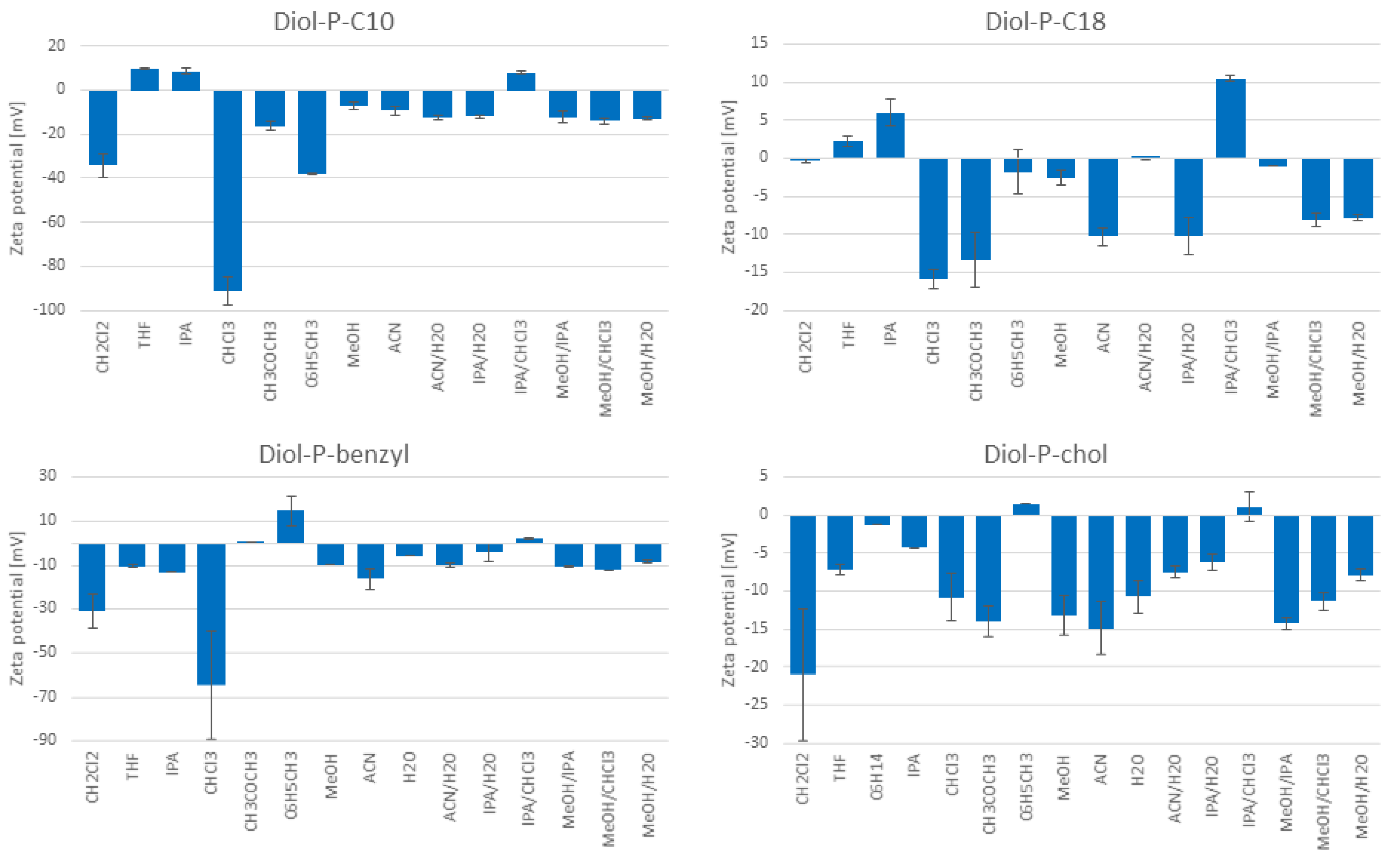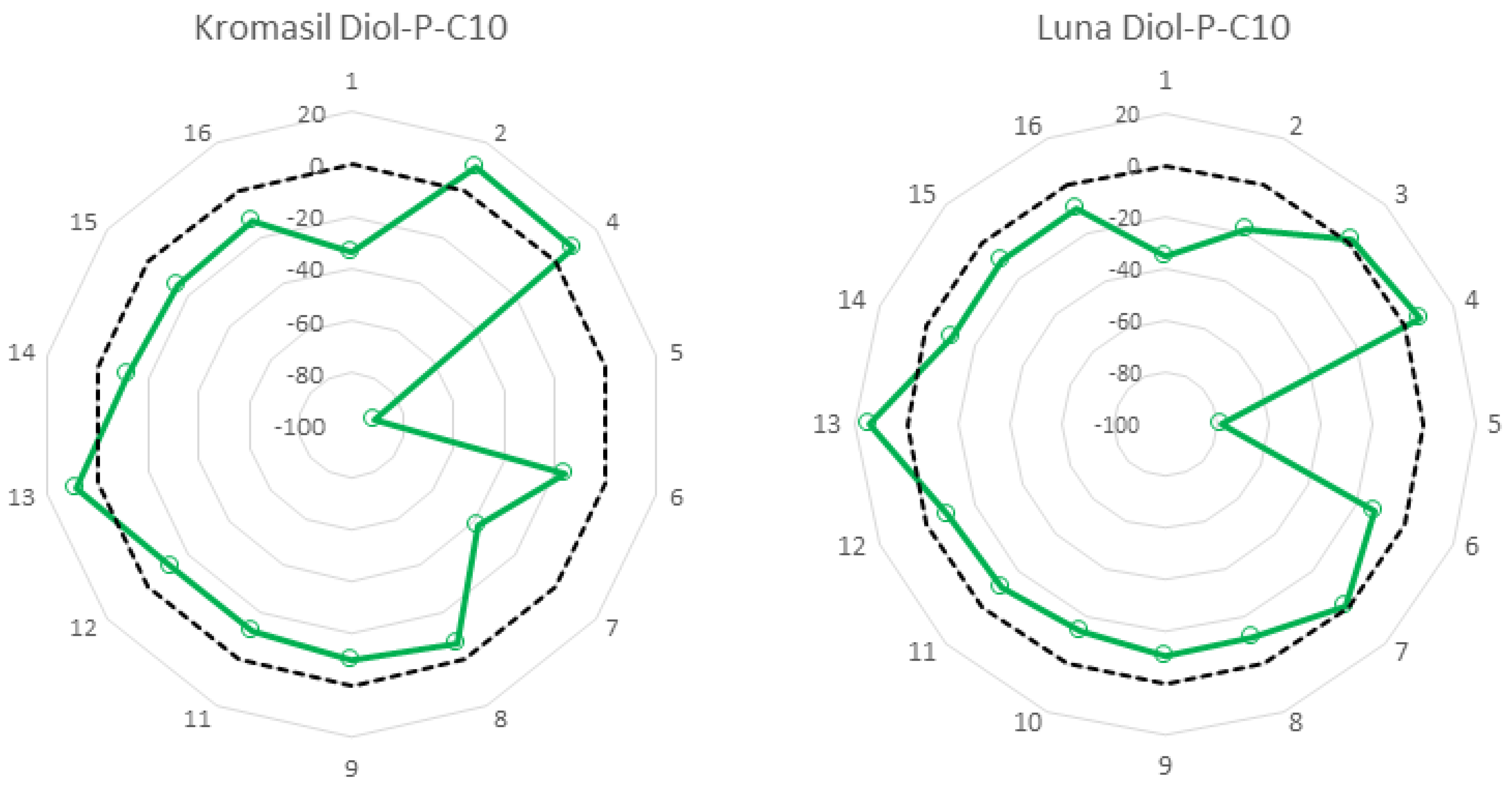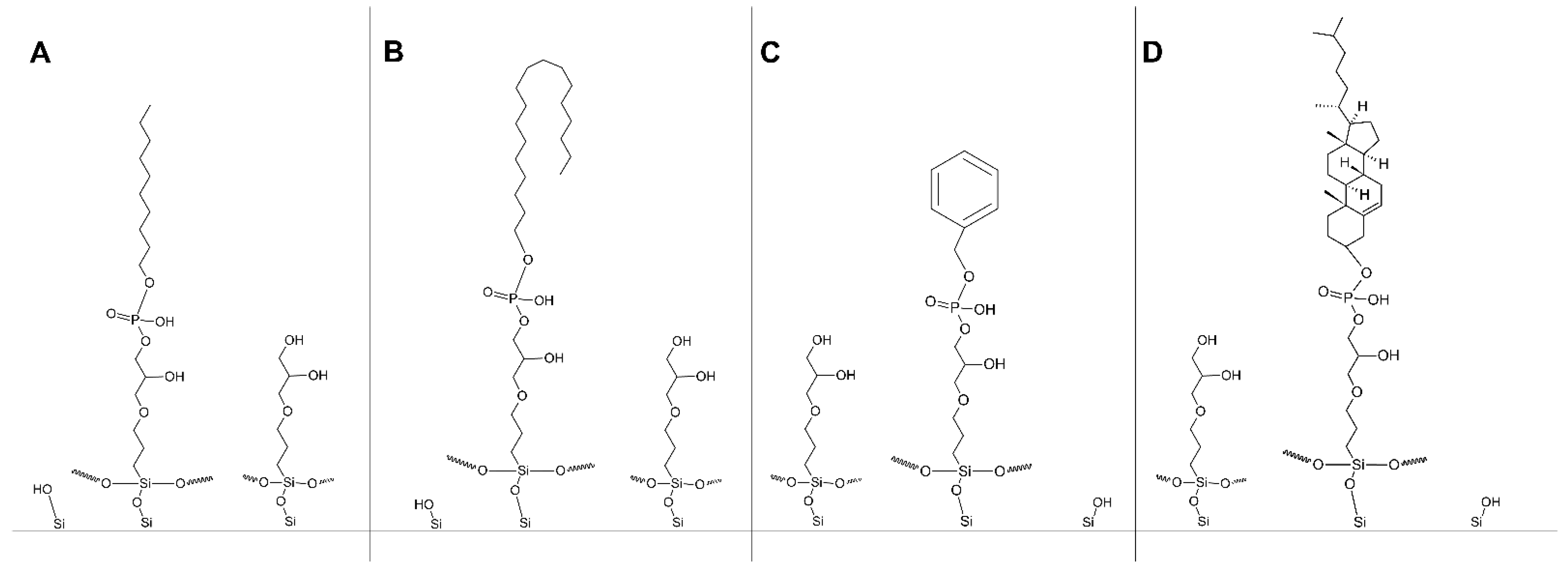Solvent Influence on Zeta Potential of Stationary Phase—Mobile Phase Interface
Abstract
:1. Introduction
2. Results and Discussion
3. Materials and Methods
3.1. Materials
3.2. Stationary Phase Synthesis
3.3. Instruments
3.4. Methods
4. Conclusions
Author Contributions
Funding
Institutional Review Board Statement
Informed Consent Statement
Data Availability Statement
Acknowledgments
Conflicts of Interest
Sample Availability
References
- Stern, H.O. Zur theorie der elektrolytischen doppelschicht. Z. Elektrochem. 1924, 30, 508–514. [Google Scholar] [CrossRef]
- Skoczylas, M.; Bocian, S.; Buszewski, B. Influence of silica functionalization by amino acids and peptides on the stationary phases zeta potential. J. Chromatogr. A 2018, 1573, 98–106. [Google Scholar] [CrossRef] [PubMed]
- Žuvela, P.; Skoczylas, M.; Jay Liu, J.; Baczek, T.; Kaliszan, R.; Wong, M.W.; Buszewski, B. Column Characterization and Selection Systems in Reversed-Phase High-Performance Liquid Chromatography. Chem. Rev. 2019, 119, 3674–3729. [Google Scholar] [CrossRef] [PubMed]
- Hunter, R.J. Zeta Potential in Colloid Science: Principles and Applications; Academic Press: London, UK, 1981; ISBN 0-12-361960-2. [Google Scholar]
- Buszewski, B.; Jaćkowska, M.; Bocian, S.; Dziubakiewicz, E. Application of the zeta potential for stationary phase characterization in ion chromatography. J. Sep. Sci. 2013, 36, 156–163. [Google Scholar] [CrossRef] [PubMed]
- Buszewski, B.; Bocian, S.; Dziubakiewicz, E. Zeta potential determination as a new way of stationary phases characterization for liquid chromatography. J. Sep. Sci. 2010, 33, 1529–1537. [Google Scholar] [CrossRef] [PubMed]
- Unger, K.K. Porous Silica; Elsevier: Amsterdam, The Netherlands, 1979; Volume 16, ISBN 9780080858166. [Google Scholar]
- Bocian, S.; Dziubakiewicz, E.; Buszewski, B. Influence of the charge distribution on the stationary phases zeta potential. J. Sep. Sci. 2015, 38, 2625–2629. [Google Scholar] [CrossRef]
- Kulsing, C.; Yang, Y.; Munera, C.; Tse, C.; Matyska, M.T.; Pesek, J.J.; Boysen, R.I.; Hearn, M.T.W. Correlations between the zeta potentials of silica hydride-based stationary phases, analyte retention behaviour and their ionic interaction descriptors. Anal. Chim. Acta 2014, 817, 48–60. [Google Scholar] [CrossRef] [PubMed]
- Kulsing, C.; Yang, Y.; Matyska, M.T.; Pesek, J.J.; Boysen, R.I.; Hearn, M.T.W. Prediction of the zeta potentials and ionic descriptors of a silica hydride stationary phase with mobile phases of different pH and ionic strength. Anal. Chim. Acta 2015, 859, 79–86. [Google Scholar] [CrossRef]
- Buszewski, B.; Bocian, S.; Felinger, A. Excess isotherms as a new way for characterization of the columns for reversed-phase liquid chromatography. J. Chromatogr. A 2008, 1191, 72–77. [Google Scholar] [CrossRef]
- Yang, Y.; Boysen, R.I.; Kulsing, C.; Matyska, M.T.; Pesek, J.J.; Hearn, M.T.W. Analysis of polar peptides using a silica hydride column and high aqueous content mobile phases. J. Sep. Sci. 2013, 36, 3019–3025. [Google Scholar] [CrossRef]
- Derjaguin, B.; Landau, L. Theory of the stability of strongly charged lyophobic sols and of the adhesion of strongly charged particles in solutions of electrolytes. Prog. Surf. Sci. 1993, 43, 30–59. [Google Scholar] [CrossRef]
- Antonio Alves Júnior, J.; Baptista Baldo, J. The Behavior of Zeta Potential of Silica Suspensions. New J. Glas. Ceram. 2014, 4, 29–37. [Google Scholar] [CrossRef] [Green Version]
- Malvern Instruments Limited. Zeta Potential: An Introduction in 30 Minutes; Zetasizer Nano Serles Technical Note MRK654-01; Malvern Instruments Limited: Worcestershire, UK, 2011; Volume 2, pp. 1–6. [Google Scholar]
- Vissers, J.P.C. Capillary LC Columns: Packing Techniques and Applications. Ph.D. Thesis, Eindhoven University of Technology, Eindhoven, The Netherlands, 1998. [Google Scholar]
- Vissers, J.P.C.; Hoeben, M.A.; Laven, J.; Claessens, H.A.; Cramers, C.A. Hydrodynamic aspects of slurry packing processes in microcolumn liquid chromatography. J. Chromatogr. A 2000, 883, 11–25. [Google Scholar] [CrossRef]
- Claessens, H.A.; Cramers, C.A.; Vissers, J.P.C.; Laven, J. Colloid Chemical Aspects of Slurry Packing Techniques in Microcolumn Liquid Chromatography. Anal. Chem. 1995, 67, 2103–2109. [Google Scholar] [CrossRef] [Green Version]
- Blue, L.E.; Jorgenson, J.W. 1.1 μm Superficially porous particles for liquid chromatography. Part II: Column packing and chromatographic performance. J. Chromatogr. A 2015, 1380, 71–80. [Google Scholar] [CrossRef]
- Grushka, E.; Scott, R.P.W. Polypeptides as a Permanently Bound Stationary Phase in Liquid Chromatography. Anal. Chem. 1973, 45, 1626–1632. [Google Scholar] [CrossRef]
- Von Smoluchowski, M. Handbuch der Elektrizitat und des Magnetismus; Greatz, L., Ed.; Barth-Verlag: Liepzig, Germany, 1921; Volume 2. [Google Scholar]
- Henry, D.C. The cataphoresis of suspended particles. Part I.—The equation of cataphoresis. Proc. R. Soc. London Ser. A Contain. Pap. Math. Phys. Character 1931, 133, 106–129. [Google Scholar] [CrossRef]
- Pyell, U.; Jalil, A.H.; Pfeiffer, C.; Pelaz, B.; Parak, W.J. Characterization of gold nanoparticles with different hydrophilic coatings via capillary electrophoresis and Taylor dispersion analysis. Part I: Determination of the zeta potential employing a modified analytic approximation. J. Colloid Interface Sci. 2015, 450, 288–300. [Google Scholar] [CrossRef]
- Ohshima, H. A simple expression for henry’s function for the retardation effect in electrophoresis of spherical colloidal particles. J. Colloid Interface Sci. 1994, 168, 269–271. [Google Scholar] [CrossRef]
- O’Brien, R.W.; White, L.R. Electrophoretic mobility of a spherical colloidal particle. J. Chem. Soc. Faraday Trans. 2 Mol. Chem. Phys. 1978, 74, 1607–1626. [Google Scholar] [CrossRef]
- Kosmulski, M.; Maczka, E. The effects of ethanol concentration and of ionic strength on the zeta potential of titania in the presence of sodium octadecyl sulfate. Colloids Interfaces 2020, 4, 49. [Google Scholar] [CrossRef]
- Kosmulski, M.; Mączka, E.; Ruchomski, L. The effect of sodium octadecyl sulfate on the electrokinetic potential of metal oxides. Colloids Surfaces A Physicochem. Eng. Asp. 2020, 605, 125353. [Google Scholar] [CrossRef]
- Jiang, W.; Irgum, K. Tentacle-type zwitterionic stationary phase prepared by surface-initiated graft polymerization of 3-[N,N-dimethyl-N-(methacryloyloxyethyl)-ammonium] propanesulfonate through peroxide groups tethered on porous silica. Anal. Chem. 2002, 74, 4682–4687. [Google Scholar] [CrossRef] [PubMed]
- Kim, J.; Lawler, D.F. Characteristics of zeta potential distribution in silica particles. Bull. Korean Chem. Soc. 2005, 26, 1083–1089. [Google Scholar] [CrossRef] [Green Version]
- Soukup, J.; Janás, P.; Jandera, P. Gradient elution in aqueous normal-phase liquid chromatography on hydrosilated silica-based stationary phases. J. Chromatogr. A 2013, 1286, 111–118. [Google Scholar] [CrossRef]
- Melnikov, S.M.; Höltzel, A.; Seidel-Morgenstern, A.; Tallarek, U. A molecular dynamics study on the partitioning mechanism in hydrophilic interaction chromatography. Angew. Chemie Int. Ed. 2012, 51, 6251–6254. [Google Scholar] [CrossRef] [PubMed]
- Bocian, S.; Rychlicki, G.; Matyska, M.; Pesek, J.; Buszewski, B. Study of hydration process on silica hydride surfaces by microcalorimetry and water adsorption. J. Colloid Interface Sci. 2014, 416, 161–166. [Google Scholar] [CrossRef]
- Zangi, R.; Engberts, J.B.F.N. Physisorption of hydroxide ions from aqueous solution to a hydrophobic surface. J. Am. Chem. Soc. 2005, 127, 2272–2276. [Google Scholar] [CrossRef] [Green Version]
- Kudin, K.N.; Car, R. Why are water-hydrophobic interfaces charged? J. Am. Chem. Soc. 2008, 130, 3915–3919. [Google Scholar] [CrossRef]
- Gray-Weale, A.; Beattie, J.K. An explanation for the charge on water’s surface. Phys. Chem. Chem. Phys. 2009, 11, 10994–11005. [Google Scholar] [CrossRef]
- Medrzycka, K.B. The effect of particle concentration on zeta potential in extremely dilute solutions. Colloid Polym. Sci. 1991, 269, 85–90. [Google Scholar] [CrossRef]
- Kaszuba, M.; Corbett, J.; Watson, F.M.N.; Jones, A. High-concentration zeta potential measurements using light-scattering techniques. Philos. Trans. R. Soc. A Math. Phys. Eng. Sci. 2010, 368, 4439–4451. [Google Scholar] [CrossRef] [PubMed] [Green Version]
- Kosmulski, M.; Mączka, E. The isoelectric point of an exotic oxide: Tellurium (iv) oxide. Molecules 2021, 26, 3136. [Google Scholar] [CrossRef]
- CH2Cl2 Viscosity. Available online: https://pubchem.ncbi.nlm.nih.gov/compound/6344, (accessed on 1 October 2021).
- Sigma Table. Available online: https://www.sigmaaldrich.com/deepweb/assets/sigmaaldrich/marketing/global/documents/614/456/labbasics_pg144.pdf, (accessed on 1 October 2021).
- Thompson, J.W.; Kaiser, T.J.; Jorgenson, J.W. Viscosity measurements of methanol-water and acetonitrile-water mixtures at pressures up to 3500 bar using a novel capillary time-of-flight viscometer. J. Chromatogr. A 2006, 1134, 201–209. [Google Scholar] [CrossRef] [PubMed]
- Mikhail, S.Z.; Kimel, W.R. Densities and Viscosities of 1-Propanol-Water Mixtures. J. Chem. Eng. Data 1963, 8, 323–328. [Google Scholar] [CrossRef]
- Sovilj, M.N. Kinematic viscosities of binary and ternary liquid mixtures involving chloroform, 2-propanol, and 2-butanol at several temperatures. J. Chem. Eng. Data 1995, 40, 1058–1061. [Google Scholar] [CrossRef]
- Canosa, J.; Rodríguez, A.; Tojo, J. Dynamic viscosities of (methyl acetate or methanol) with (ethanol, 1-propanol, 2-propanol, 1-butanol, and 2-butanol) at 298.15 K. J. Chem. Eng. Data 1998, 43, 417–421. [Google Scholar] [CrossRef]
- Mohammadi, M.D.; Hamzehloo, M. Densities, viscosities, and refractive indices of binary and ternary mixtures of methanol, acetone, and chloroform at temperatures from (298.15–318.15) K and ambient pressure. Fluid Phase Equilib. 2019, 483, 14–30. [Google Scholar] [CrossRef]
- Nawrocki, J. The silanol group and its role in liquid chromatography. J. Chromatogr. A 1997, 779, 29–71. [Google Scholar] [CrossRef]
- Méndez, A.; Bosch, E.; Rosés, M.; Neue, U.D. Comparison of the acidity of residual silanol groups in several liquid chromatography columns. J. Chromatogr. A 2003, 986, 33–44. [Google Scholar] [CrossRef]
- Buszewski, B.; Bocian, S.; Rychlicki, G.; Matyska, M.; Pesek, J. Determination of accessible silanols groups on silica gel surfaces using microcalorimetric measurements. J. Chromatogr. A 2012, 1232, 43–46. [Google Scholar] [CrossRef] [PubMed]
- Ståhlberg, J. Retention models for ions in chromatography. J. Chromatogr. A 1999, 855, 3–55. [Google Scholar] [CrossRef]



| Solvent/ Mixture Number | Solvent/Solvent Mixture (1/1 v/v) | Viscosity µ [cP] (20 ˚C) | Dielectric Constant εr (20 °C) | Refractive Index RI | Literature |
|---|---|---|---|---|---|
| 1 | Dichloromethane | 0.43 | 9.08 | 1.424 | [39,40] |
| 2 | Tetrahydrofuran | 0.55 | 7.60 | 1.407 | [40] |
| 3 | Hexane | 0.31 | 1.89 | 1.375 | [40] |
| 4 | Isopropanol | 2.86 (15 °C) | 18.3 (25 °C) | 1.377 | [40] |
| 5 | Chloroform | 0.85 | 4.81 | 1.446 | [40] |
| 6 | Acetone | 0.32 | 20.7 (25 °C) | 1.359 | [40] |
| 7 | Toluene | 0.59 | 2.4 (25 °C) | 1.496 | [40] |
| 8 | Methanol | 0.55 | 32.6 (25 °C) | 1.329 | [40] |
| 9 | Acetonitrile | 0.37 | 37.5 | 1.344 | [40] |
| 10 | Water | 1.00 | 78.54 | 1.333 | [40] |
| 11 | Acetonitrile/Water | 0.81 | 58.02 | 1.336 | [40,41] |
| 12 | Isopropanol/Water | 2.58 | 48.42 | 1.355 | [40,42] |
| 13 | Isopropanol/Chloroform | 0.64 | 11.6 | 1.411 | [40,43] |
| 14 | Methanol/Isopropanol | 0.97 | 25.5 | 1.353 | [40,44] |
| 15 | Methanol/Chloroform | 0.65 | 18.7 | 1.383 | [40,45] |
| 16 | Methanol/Water | 1.54 | 78.5 | 1.340 | [40,41] |
| Parameter | Kromasil 100 | Luna |
|---|---|---|
| Particle size [µm] | 5 | 5 |
| Specific surface area [m2/g] | 320 | 400 |
| Average pore size [nm] | 11 | 10 |
| Pore volume [cm3/g] | 0.9 | 1.0 |
| Stationary Phase | Carbon Load [%] | Coverage Density [µmol/m2] |
|---|---|---|
| Diol-P-C10 | 3.43 | 0.56 |
| Diol-P-C18 | 4.18 | 0.42 |
| Diol-P-Benzyl | 2.86 | 0.56 |
| Diol-P-Chol | 9.31 | 0.87 |
| Luna-P-C10 | 4.58 | 0.51 |
Publisher’s Note: MDPI stays neutral with regard to jurisdictional claims in published maps and institutional affiliations. |
© 2022 by the authors. Licensee MDPI, Basel, Switzerland. This article is an open access article distributed under the terms and conditions of the Creative Commons Attribution (CC BY) license (https://creativecommons.org/licenses/by/4.0/).
Share and Cite
Dembek, M.; Bocian, S.; Buszewski, B. Solvent Influence on Zeta Potential of Stationary Phase—Mobile Phase Interface. Molecules 2022, 27, 968. https://doi.org/10.3390/molecules27030968
Dembek M, Bocian S, Buszewski B. Solvent Influence on Zeta Potential of Stationary Phase—Mobile Phase Interface. Molecules. 2022; 27(3):968. https://doi.org/10.3390/molecules27030968
Chicago/Turabian StyleDembek, Mikołaj, Szymon Bocian, and Bogusław Buszewski. 2022. "Solvent Influence on Zeta Potential of Stationary Phase—Mobile Phase Interface" Molecules 27, no. 3: 968. https://doi.org/10.3390/molecules27030968
APA StyleDembek, M., Bocian, S., & Buszewski, B. (2022). Solvent Influence on Zeta Potential of Stationary Phase—Mobile Phase Interface. Molecules, 27(3), 968. https://doi.org/10.3390/molecules27030968








